A Model to Evaluate the Flooding Opportunity and Sustainable Use of Former Open-Pits
Abstract
:1. Introduction
2. Materials and Methods
2.1. Assessing Criteria
- Geomorphology and orography of the area;
- Configuration of the remaining gap;
- Necessity of appearance of a water body in the area;
- Necessity to restore the aquifer resources;
- Hydrology and hydrogeology of the region;
- Stability conditions of the final slopes of the remaining gap;
- Accessibility and distance to the areas of interest;
- Investment for the recovery and rehabilitation of the remaining gap;
- Population requirements.
2.1.1. Criterion C1—Geomorphology and Orography of the Area
2.1.2. Criterion C2—Configuration of the Remaining Gap
2.1.3. Criterion C3—Necessity to Restore the Aquifer Resources
- x—the value of the land (grade); c—the priority coefficient; Mp—the weighted average.
| Type of Land Use | Priority Coefficient, c |
|---|---|
| Urban areas | 4 |
| Agricultural areas | 3 |
| Industrial areas | 2 |
| Protected areas, natural areas, forested areas, lake and river areas, poor lands, transport, communications, and utilities | 1 |
2.1.4. Criterion C4—Necessity of Appearance of a Water Body in the Area
2.1.5. Criterion C5—Hydrology and Hydrogeology of the Region
- QP/QE > 1—precipitations has an insignificant (QP/QE = 1 ÷ 1.1), or a significant contribution (if QP/QE > 1) to open-pit flooding;
- QP/QE = 1—there is no discharge or charge of the lake;
- QP/QE < 1—relatively low discharge of water from the lake. Another situation can occur, respectively when QP → 0 and QE > 0 results a significant discharge of the lake.
2.1.6. Criterion C6—Stability Conditions of the Final Slopes
2.1.7. Criterion C7—Accessibility and Distance to the Areas of Interest
2.1.8. Criterion C8—Investments for Land Recovery and Rehabilitation
- Insignificant investments—flooding, recovery, and reintegration into the landscape occur naturally within an acceptable period of time.
- Reduced investments—flooding, recovery, and reintegration into the landscape occur naturally, but some anthropogenic interventions are needed to accelerate the processes: leveling and resloping, use of existing objectives, etc.
- Medium investments—flooding, recovery, and reintegration into the landscape are done naturally and anthropically through the water supply, being necessary other anthropic interventions: resloping, leveling, compaction, remodeling, accelerating the process of revegetation, reconstruction, transformation or development of existing objectives, etc.
- High and very high investments—flooding, recovery, and reintegration into the landscape are mostly anthropogenic: water supply, resloping, leveling, compaction, remodeling of banks, revegetation, construction of new objectives, etc.
2.1.9. Criterion C9—Population Requirements
- the value of a constant (c) is determined using Equation (2);
- the final score is determined using Equation (3);
2.2. Evaluation Matrix
3. Results
3.1. Assessing the Opportunity of Flooding the Lignite Open-Pits from Rovinari Mining Basin
3.1.1. Geomorphology and Orography of the Area (C1)
3.1.2. Configuration of the Remaining Gap (C2)
3.1.3. Necessity to Restore the Aquifer Resources (C3)
3.1.4. Necessity of Appearance of a Water Body in the Area (C4)
3.1.5. Hydrology and Hydrogeology of the Region (C5)
3.1.6. Stability Conditions of the Final Slopes (C6)
3.1.7. Accessibility and Distance to the Areas of Interest (C7)
3.1.8. Investments for Land Recovery and Rehabilitation (C8)
3.1.9. Population Requirements (C9)
3.2. Final Evaluation of Flooding Opportunity
4. Conclusions and Final Remarks
Author Contributions
Funding
Acknowledgments
Conflicts of Interest
References
- Brundtland, G. Report of the World Commission on Environment and Development: Our Common Future; Oxford University Press: Oxford, UK; New York, NY, USA, 1987. [Google Scholar]
- McCullough, C.D.; Schultze, M.; Vandenberg, J. Realizing Beneficial End Uses from Abandoned Pit Lakes. Minerals 2020, 10, 133. [Google Scholar] [CrossRef] [Green Version]
- Lazar, M. Stability and Ecological Reconstruction of the Land Affected by Mining; Reports of Professorship Surface Mining; Technische Universität Bergakademie: Freiberg, Germany, 2017. [Google Scholar]
- Blanchette, M.L.; Lund, M.A. Pit lakes are a global legacy of mining: An integrated approach to achieving sustainable ecosystems and value for communities. Curr. Opin. Environ. Sustain. 2016, 23, 28–34. [Google Scholar] [CrossRef]
- Geller, W.; Schultze, M.; Kleinmann, R.; Wolkersdorfer, C. Acidic Pit Lakes-The Legacy of Coal and Metal Surface Mines; Springer: Berlin/Heidelberg, Germany, 2013. [Google Scholar] [CrossRef]
- Oszkinis-Golon, M.; Frankowski, M.; Jerzak, L.; Pukacz, A. Physicochemical Differentiation of the Muskau Arch Pit Lakes in the Light of Long-Term Changes. Water 2020, 12, 2368. [Google Scholar] [CrossRef]
- Maest, A.; Prucha, R.; Wobus, C. Hydrologic and Water Quality Modeling of the Pebble Mine Project Pit Lake and Downstream Environment after Mine Closure. Minerals 2020, 10, 727. [Google Scholar] [CrossRef]
- Lazăr, M.; Faur, F. Research on the possibility of the development and water filling of the remaining hole of Urdari open pit. Min. Rev. 2012, 18, 18–22. [Google Scholar]
- Apostu, I.M.; Faur, F. Identification and analysis of geotechnical risks in the conditions of flooding of the remaining gaps. In Proceedings of the 9th International Conference on Manufacturing Science and Education, Sibiu, Romania, 21 August 2019; p. 290. [Google Scholar]
- Doupé, R.G.; Lymbery, A.J. Environmental risks associated with beneficial end uses of mine lakes in southwestern Australia. Mine Water Environ. 2005, 24, 134–138. [Google Scholar] [CrossRef]
- Schultze, M.; Pokrandt, K.H.; Hille, W. Pit lakes of the Central German lignite mining district: Creation, morphometry and water quality aspects. Limn. Ecol. Manag. Inland Waters 2010, 40, 148–155. [Google Scholar] [CrossRef] [Green Version]
- Soni, A.; Mishra, B.; Singh, S. Pit lakes as an end use of mining: A review. J. Min. Environ. 2014, 5, 99–111. [Google Scholar]
- McCullough, C.D.; Marchand, G.; Unseld, J. Mine Closure of Pit Lakes as Terminal Sinks: Best Available Practice When Options are Limited? Mine Water Environ. 2013, 32, 302–313. [Google Scholar] [CrossRef] [Green Version]
- Vandenberg, J.A.; McCullough, C.D.; Bolan, N.; Kirkham, M.; Ok, Y. Spoil to Soil; Informa UK Limited: Colchester, UK, 2017; pp. 175–188. [Google Scholar]
- McCullough, C.D.; Lund, M.A. Opportunities for Sustainable Mining Pit Lakes in Australia. Mine Water Environ. 2006, 25, 220–226. [Google Scholar] [CrossRef]
- McCullough, C.D.; Hunt, D.; Evans, L.H. Sustainable Development of Open Pit Mines: Creating Beneficial End Uses for Pit Lakes. In Mine Pit Lakes: Characteristics, Predictive Modeling, and Sustainability; Castendyk, D.N., Eary, L.E., Eds.; Society for Mining, Metallurgy and Exploration (SME): Englewood, CO, USA, 2009; pp. 249–268. [Google Scholar]
- McCullough, C.D.; Schultze, M. Risks and Rewards of Pit Lakes. AusIMM Bull. 2018, 2018, 38–41. [Google Scholar]
- Gerner, M.; McCullough, C.D. From Start to Finish: A Life of Mine Perspective; AusIMM: Brisbane, Australia, 2018; pp. 249–258. [Google Scholar]
- Hinwood, A.L.; Heyworth, J.; Tanner, H.; McCullough, C.D. Mine Voids Management Strategy (II): Review of Potential Health Risks Associated with Recreational Use of the Collie Pit Lakes; Edith Cowan University: Perth, Australia, 2010. [Google Scholar]
- Jones, H.; McCullough, C.D. Regulator Guidance and Legislation Relevant to Pit Lakes. In Mine Pit Lakes: Closure and Management; McCullough, C.D., Ed.; Australian Centre for Geomechanics: Perth, Australia, 2011; pp. 137–152. [Google Scholar]
- Evans, L.; Cronin, D.; Doupé, R.G.; Hunt, D.; Lymbery, A.J.; McCullough, C.D.; Tsvetnenko, Y. Potential of Pit Lakes as a Positive Post-Mining Option—Examples, Issues and Opportunities; Centre for Sustainable Mine Lakes: Perth, Australia, 2005. [Google Scholar]
- Charette, T.; Wylynko, D. Generating Regional Guidance for Best Practice Pit Lake Closure and Reclamation. In Mine Pit Lakes: Closure and Management; McCullough, C.D., Ed.; Australian Centre for Geomechanics: Perth, Australia, 2011; pp. 43–52. [Google Scholar]
- Sanchez, L.E.; Sanchez, S.S.S.; Neri, A. Guide for Mine Closure Planning; Instituto Brasileiro de Mineração: Brasilia, Brazil, 2014. [Google Scholar]
- Swanson, S. What Type of Lake Do We Want? Stakeholder Engagement in Planning for Beneficial End Uses of Pit Lakes. In Mine Pit Lakes: Closure and Management; McCullough, C.D., Ed.; Australian Centre for Geomechanics: Perth, Australia, 2011; pp. 29–42. [Google Scholar]
- Schultze, M.; Pokrandt, K.-H.; Scholz, E.; Jolas, P. Use of Mine Water for Filling and Remediation of Pit Lakes. In Proceedings of the International Mine Water Association (IMWA) Congress, Aachen, Germany, 4–11 September 2011. [Google Scholar]
- Johnson, S.L.; Wright, A.H. Mine Void Water Resource Issues in Western Australia; Water and Rivers Commission: Perth, Australia, 2003; p. 93.
- Apostu, I.; Lazar, M. Possibilities of flooding of the remaining gaps of the quarries from the Rovinari Mining Basin. In Proceedings of the Scientific Reports on Resource Issues, Holistic Approach in the Mineral Industry-Innovations in Geology, Mining, Processing, Economics, Safety and Environmental Management, Freiberg, Germany, 6 September 2018. [Google Scholar]
- Huidu, E. Open-Pit Mining Exploitation of Coal Deposits; Măiastra Publishing House: Târgu-Jiu, Romania, 2012. [Google Scholar]
- Lazăr, M. Surface Water Management; Universitas Publishing House: Petrosani, Romania, 2001. [Google Scholar]
- Rotunjanu, I.; Lazăr, M. Hydrological classification and evaluation of coal deposits. Min. Rev. 2014, 20, 7–14. [Google Scholar]
- Nyari, I.M.; Lazăr, M.; Faur, F. Methodology for Assessing the Opportunities of Flooding of the Remaining Gaps of Lignite Open-Pits. In Proceedings of the 17th International Multidisciplinary Scientific GeoConference SGEM, Albena, Bulgaria, 29 June 2017; pp. 635–642. [Google Scholar]
- Lazăr, M.; Faur, F.; Apostu, I.M. Influence of the flooding speed of former lignite open pits on the stability of final slopes. Proceedings ot the MATEC Web of Conference, Petroșani, Romania, 17 January 2020; Volume 305, p. 00040. [Google Scholar]
- Rotunjanu, I. Slope Stability; Infomin. Publishing House: Petrosani, Romania, 2005. [Google Scholar]
- Road Classification, Mobility and Transport. (E. Commission, Producer). Available online: https://ec.europa.eu/transport/road_safety/specialist/knowledge/road/designing_for_road_function/road_classification_en (accessed on 10 March 2020).
- Lazăr, M. Rehabilitation of Degraded Lands; Universitas Publishing House: Petrosani, Romania, 2010. [Google Scholar]
- Lazăr, C. Economy, Efficiency and Financing of Investments; Economical Publishing House: Bucharest, Romania, 2002. [Google Scholar]
- Apostu, I.; Lazăr, M.; Faur, F. Researches regarding the population exigencies in the conditions of recovery and reuse of the remaining gaps of the quarries. Min. Rev. 2018, 24, 20–24. [Google Scholar]
- Institute for Scientific Research, Technological Engineering and Lignite Mine Designs-S.A. Craiova (I.S.C.T.E.LM.D.). Report on the Environmental Impact Study, Continuation of Mining Works in the North Pesteana Perimeter Proposed to be Located in the Extravilan/Intravilan Areas of Urdari, Bălteni and Plopșoru Communes, Gorj County, Symbol 810 – 537; S.A. Craiova: Craiova, Romania, 2012. [Google Scholar]
- Sustainable Development Strategy of Gorj County for the Period 2011–2020. “European Strategy, European Administration, European Citizens” Project; Annex no. 1 to the Decision of the Local Council (D.L.C.) no. 28; DLC: Gorj, Romania, 2010.
- Nyari, I.; Lazar, M. Flooding of the remaining gap of North Peșteana quarry in order to create a water reservoir for irrigations. RJAS 2017, 49, 9–19. [Google Scholar]
- Păltineanu, C. , Mihăilescu, I.F., Seceleanu, I., Dragotă, C., Vasenciuc, F. Aridity, Drought, Evapotranspiration and Water Requirements of Agricultural Crops in Romania; Ovidius University Press: Constanța, Romania, 2007. [Google Scholar]
- Lazăr, M. Capitalization of Thin Layers in the Open-Pit Exploitation Perimeters in the Oltenia Area. Ph.D. Thesis, University of Petrosani, Petrosani, Romania, 1998. [Google Scholar]
- Mihai, I.; Onescu, A. Geotechnical Study for the Hilly Area on the Advancing Direction of Roșia de Jiu Open-Pit; Project no. Geo-66; Geoconsulting Design, Research and Development Company: Tg. Jiu, Romania, 2015. [Google Scholar]
- Smeu, A. Efficient Solutions for the Construction and Management of Waste Dumps in the Rovinari and Motru Mining Basins for Rendering in the Economic Circuit. Ph.D. Thesis, University of Petrosani, Petrosani, Romania, 2012. [Google Scholar]
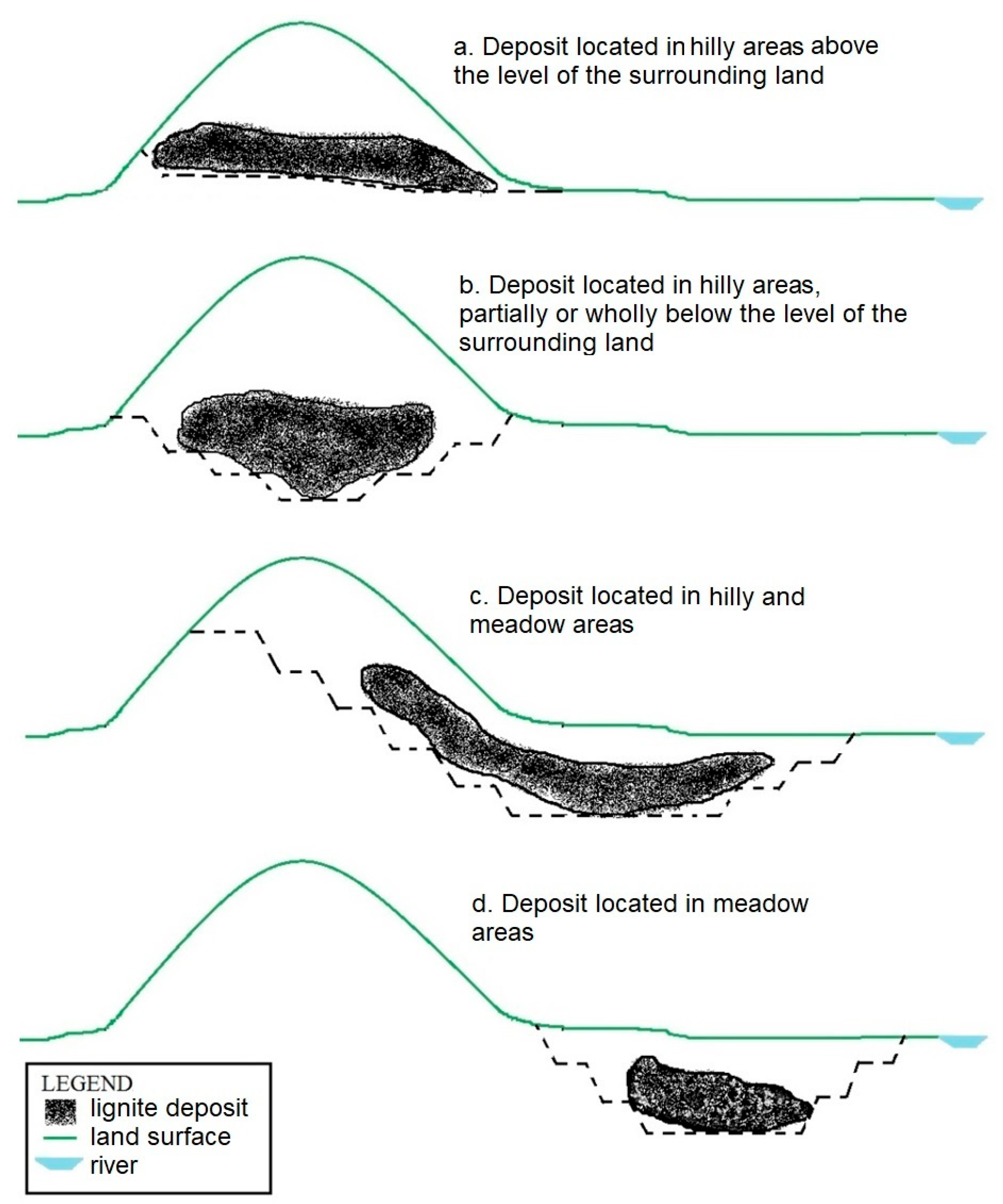
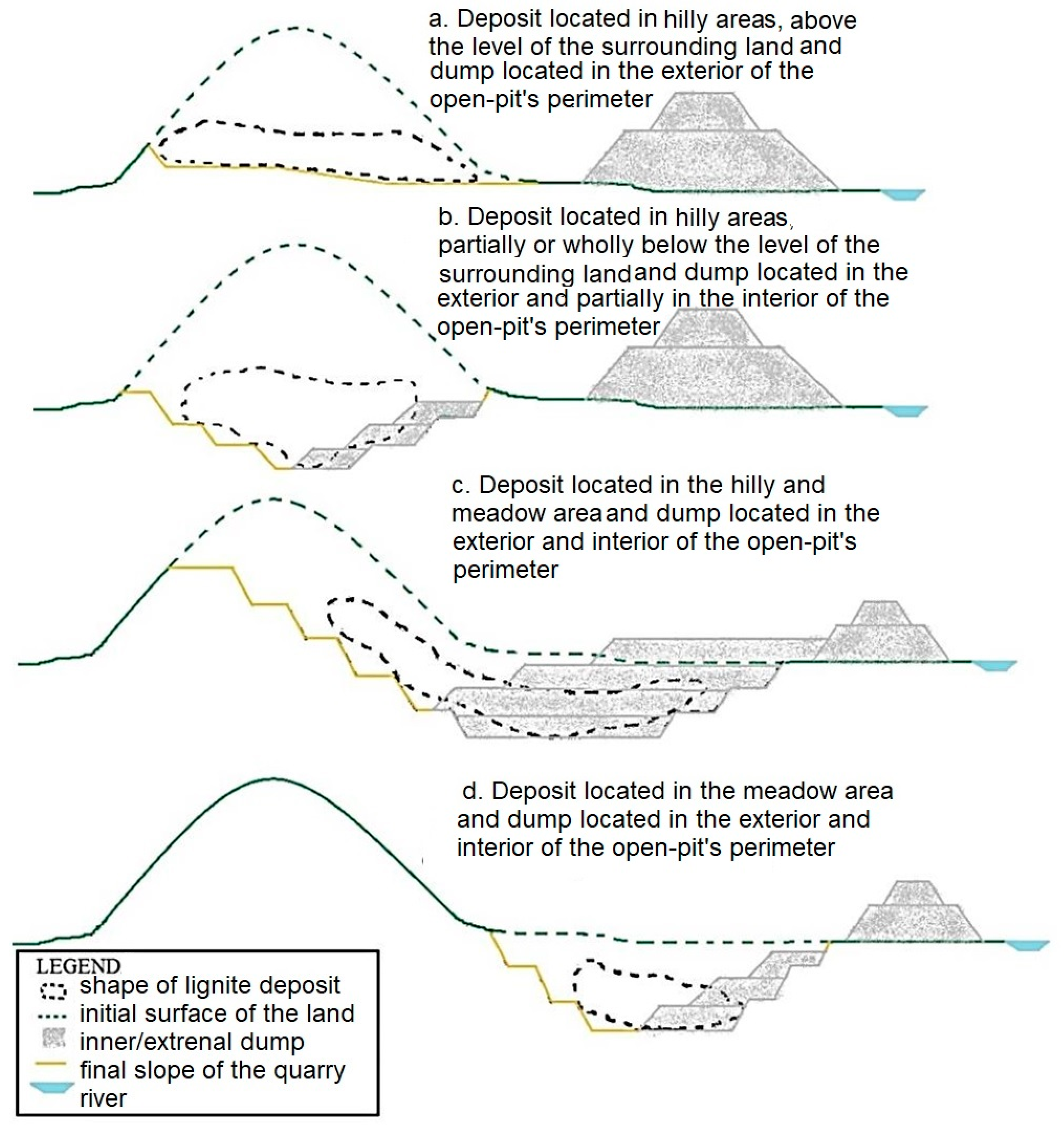
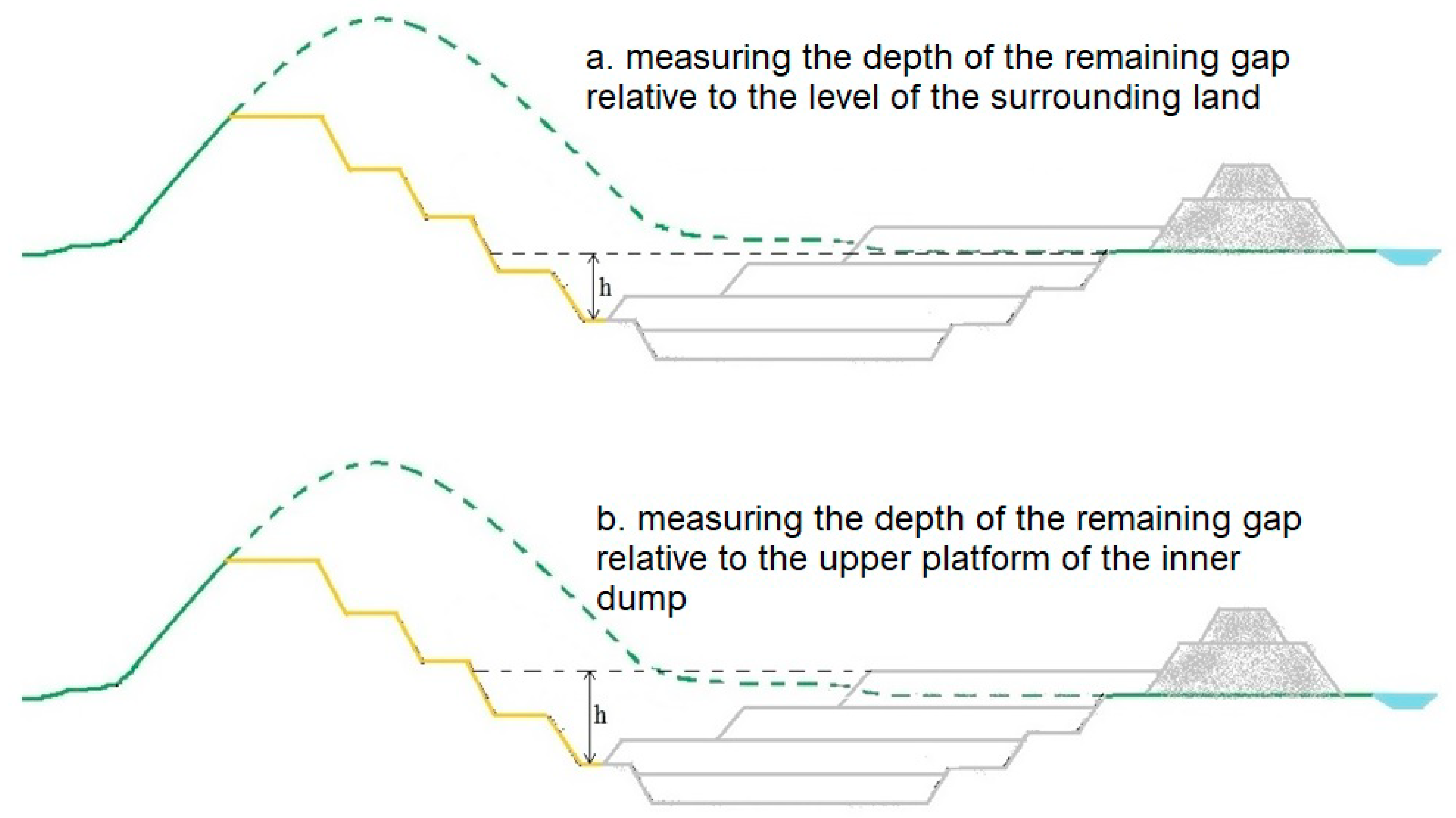
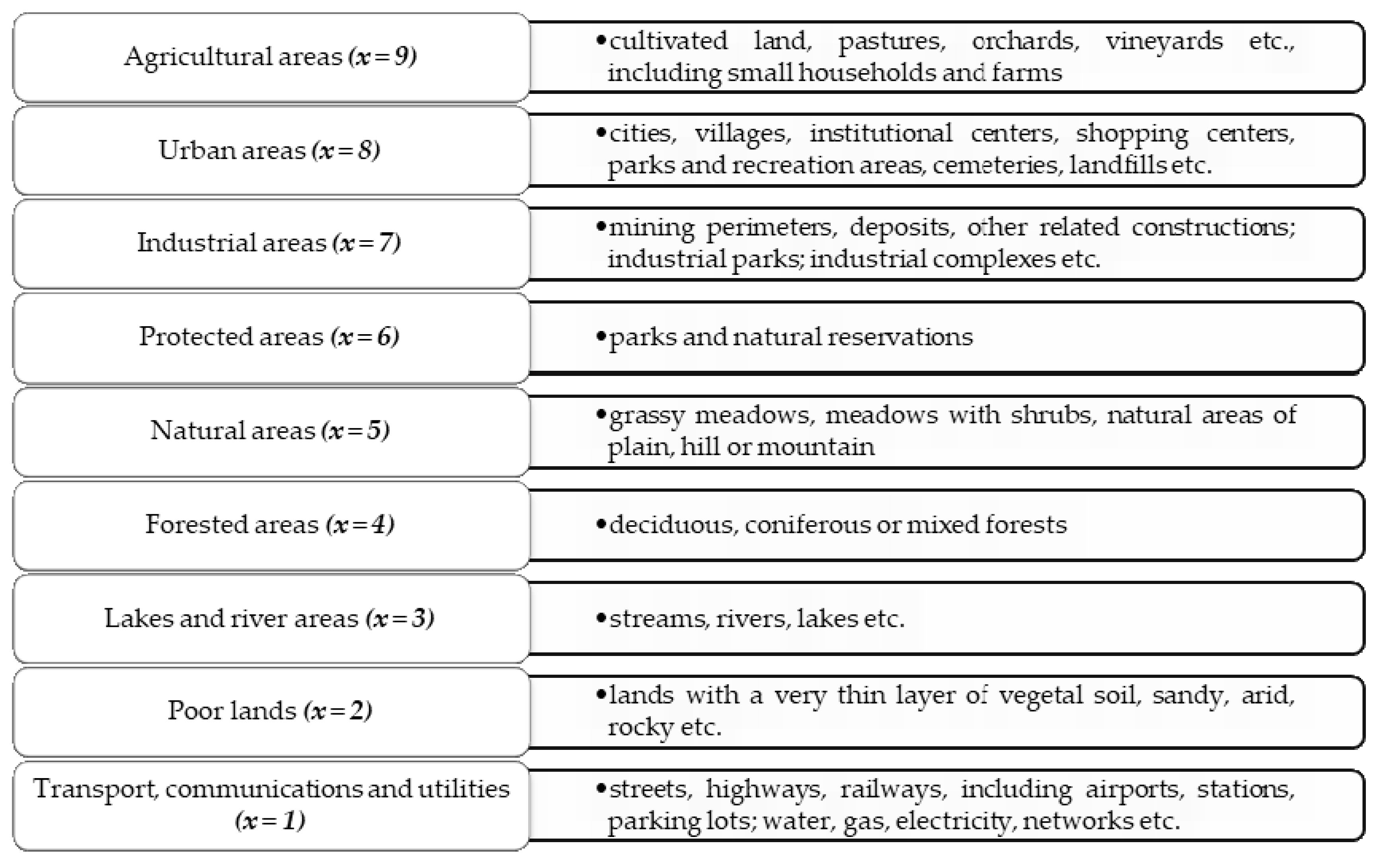
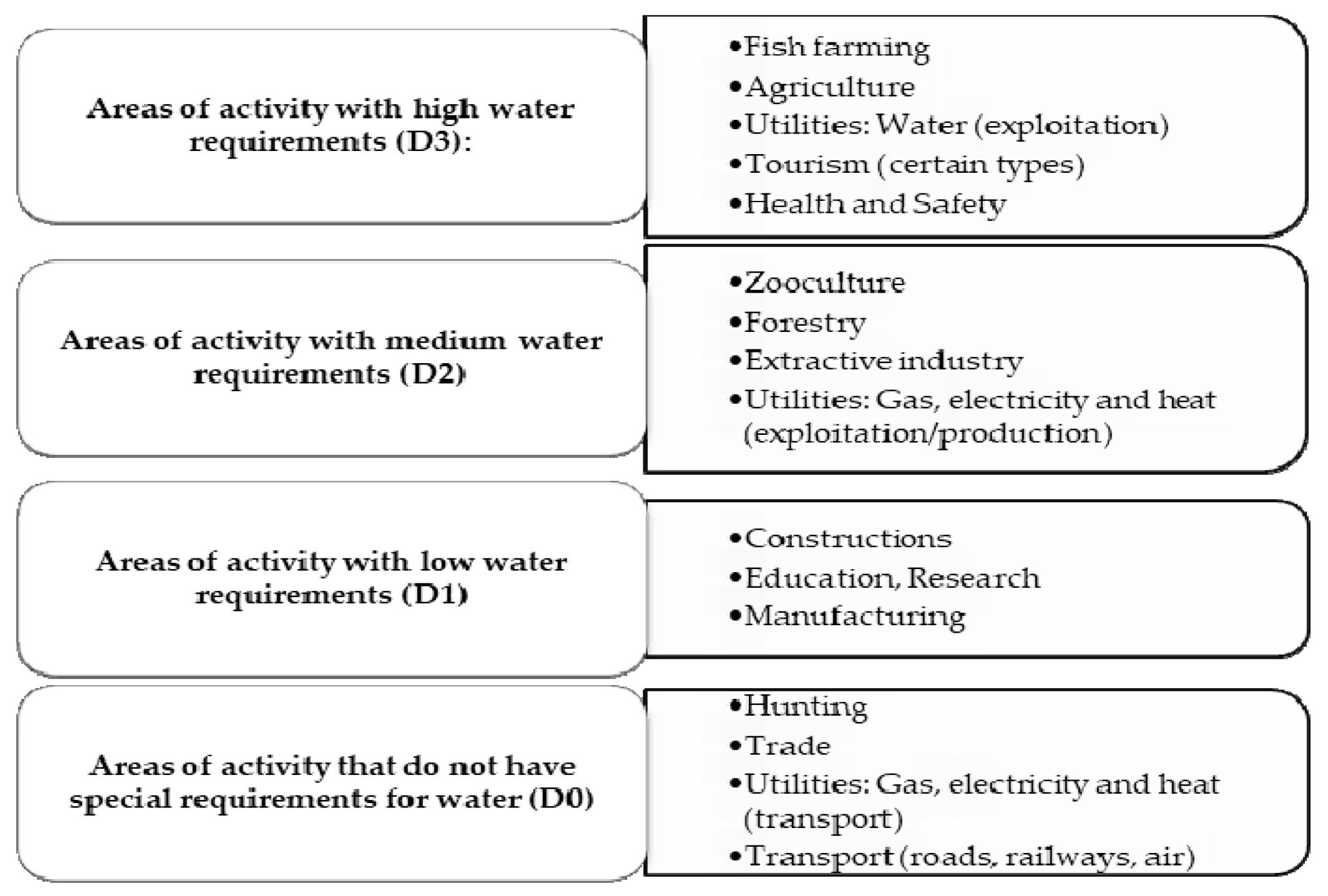
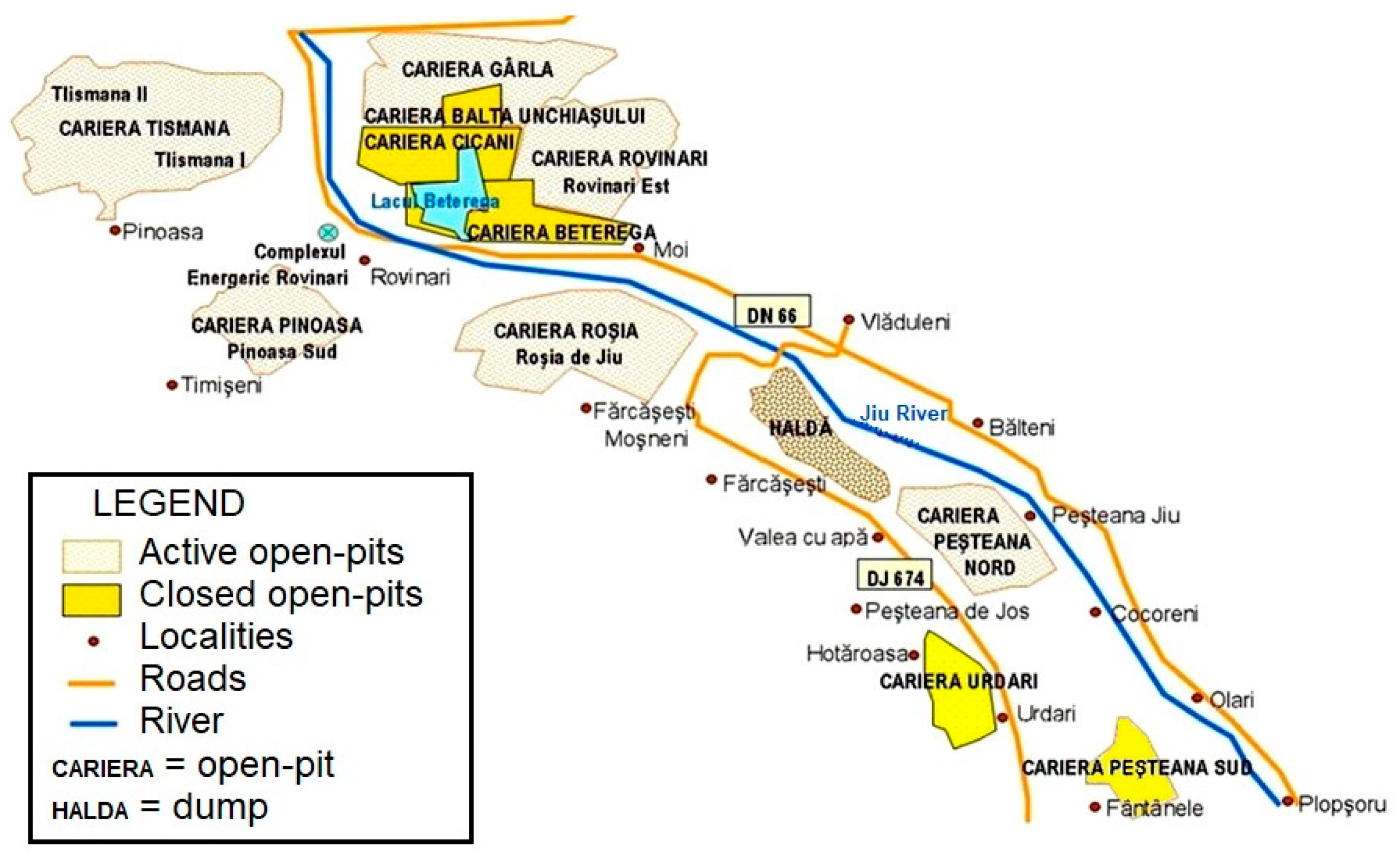
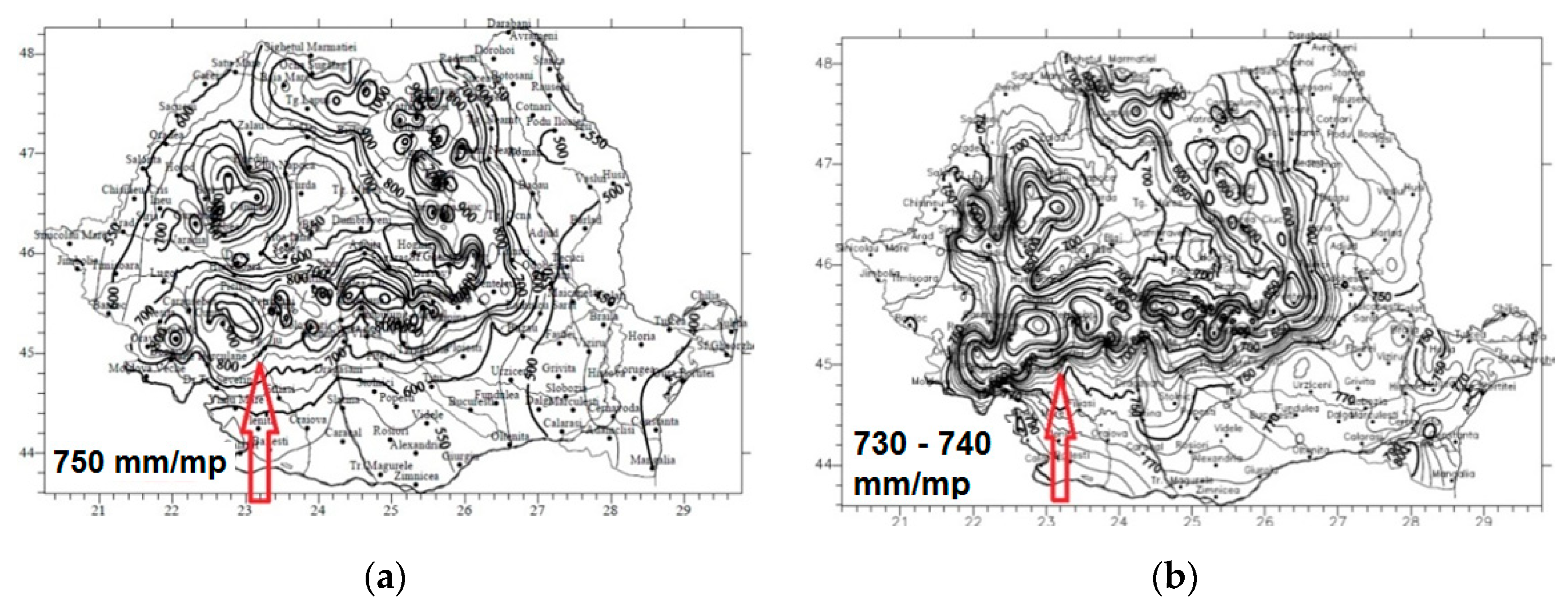
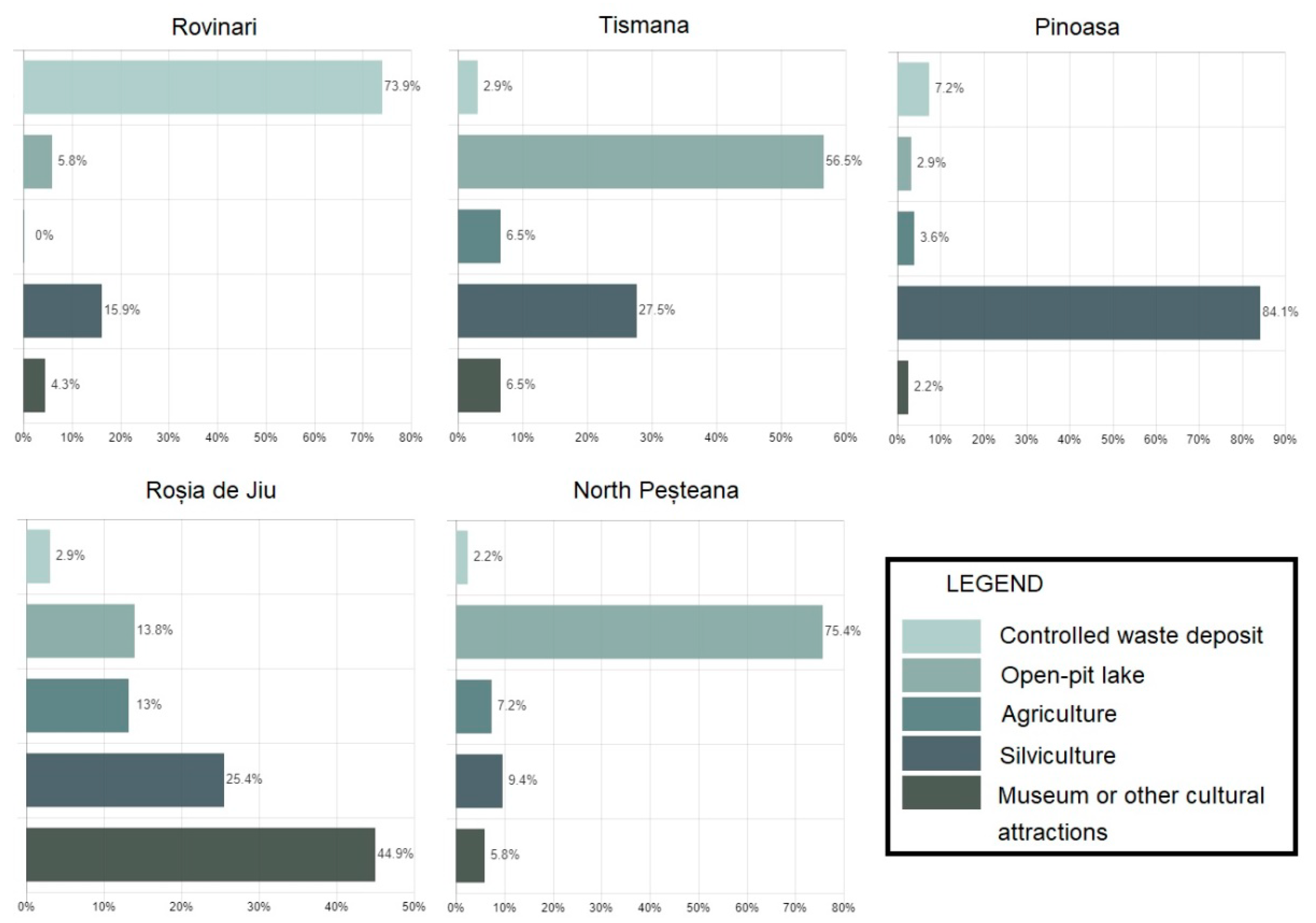
| Score Criterion 1 | P = 0—Inopportune | P = 1—Reduced Opportunity | P = 2—Average Opportunity | P = 3—High Opportunity |
|---|---|---|---|---|
| C1 | hilly or mountain area, the deposit is above the level of the surrounding land, practically does not result in a gap | hilly (or hilly and meadow area with extension to the hilly area) or mountain area, the deposit is partially or completely below the level of the surrounding land, reduced probability of occurrence of a remaining gap (it is likely to result in a remaining gap, but its dimensions are usually small) | hilly or hilly and meadow area, relatively high probability of occurrence of a remaining gap | meadow area, high probability of occurrence of a remaining gap |
| C2 | practically does not result in a gap, h = 0 m | shallow depth of the remaining gap, h = 0–10 m | medium depth of the remaining gap, h = 10–30 m | high depth of the remaining gap, h > 30 m |
| C3 | Mp ≤ 2; predominates lands without special water requirements and for which water supply is not a priority; it is not necessary to restore the aquifer resources; | 2 < Mp ≤ 5; predominates lands with low water requirements, for which water supply is not a priority; the average need for restoration of aquifer resources; | 5 < Mp ≤ 7.5; predominates lands with average water requirements, for which water supply is a priority; high need for restoration of aquifer resources | 7.5 < Mp ≤ 9; predominates lands with high water requirements, for which water supply is a priority; major need for restoration of aquifer resources. |
| C4 | for the domain of activity that does not have water requirements (D0), there is no need for creating a lake | for the domain of activity that has low water requirements (D1), reduced need for creating a lake | for the domain of activity that has average water requirements (D2), the average necessity of creating a lake | for the domain of activity that has high demands on water (D3), a major need of creating a lake |
| C5 | QP → 0, QE = +, it results in a significant discharge of the lake 1st class, mining perimeter with reduced possibility of flooding from aquifer formations; a mixture of aquifer rocks (sands, gravels, etc.) | QP/QE < 1, results in a relatively small discharge of the lake, but that can be covered by the influx of water from the aquifer formations class II, mining perimeter with the average possibility of flooding from aquifer formations; a mixture of predominantly aquiferous rocks | QP/QE = 1, results that rainfall does not contribute to the flooding of the remaining gap, but there is no loss of water from the lake class III, mining perimeter with a high possibility of flooding from aquifer formations; a mixture of predominantly aquiclude rocks | QP/QE > 1, results that rainfall has an insignificant (QP/QE = 1 ÷ 1.1), or a significant (if QP/QE > 1) contribution to flooding the remaining gap class IV, mining perimeter with a major possibility of flooding from aquifer formations; a mixture of aquiclude rocks (marls, clays, etc.) |
| C6 | 4th class of stability, Fs <1, unstable slopes, with active displacements; | 3rd class of stability, slopes with reduced stability / at the limit of stability, Fs ≈ 1, slopes that can enter dangerous movement even as a result of the individual action of some triggering factors (such as the presence of water in the body of the slope as a result of heavy rainfall, explosions, earthquakes, vibrations from the vehicles of high tonnage machines or overloads given by overloading the berms/platforms, etc.); | 2nd class of stability, slopes with high stability, Fs = 1.25 ÷ 1.5, slopes at which possible displacements can be recorded in case of concomitant or individual action of some triggering factors, but which can be limited by arrangements; | 1st class of stability, Fs > 1.5, slopes with high stability reserve, at which the probability of sliding is very low or even zero (only in case of the simultaneous action of several triggering factors can slip phenomena). |
| C7 | dirt roads improved or unimproved, temporary, strictly for driving vehicles, closed to public traffic, hardly accessible very long distance from the areas of interest (>50 km) | paved roads, opened or closed to public traffic, accessible, very low traffic relatively large distance from the areas of interest (10–50 km) | semi-permanent roads, opened to public circulation, easily accessible, low traffic or medium medium distance from the areas of interest (1–10 km); | permanent roads, opened to public traffic, easy access, heavy or very intense traffic low distance from the areas of interest (0–1 km) |
| C8 | high or very high investments | average investments | reduced investments | does not require investment or involves very small, insignificant investments |
| C9 | , (see Equation (3)) | |||
| Perimeter | Adjacent Areas | Value, x | Priority Coefficient, c | Weighted Average, Mp |
|---|---|---|---|---|
| Tismana | Industrial | 7 | 2 | 6.85 |
| Forested | 4 | 1 | ||
| Agricultural | 9 | 3 | ||
| River | 3 | 1 | ||
| Rovinari | Industrial | 7 | 2 | 7.5 |
| Forested | 4 | 1 | ||
| Agricultural | 9 | 3 | ||
| Pinoasa | Forested | 4 | 1 | 7.75 |
| Agricultural | 9 | 3 | ||
| Roșia de Jiu | Urban | 8 | 4 | 7.33 |
| Forested | 4 | 1 | ||
| Agricultural | 9 | 3 | ||
| River | 3 | 1 | ||
| North Peșteana | Agricultural | 9 | 3 | 7.5 |
| Perimeter | Areas of Interest | Distance (km) |
|---|---|---|
| Tismana | Rovinari city | 5–6 |
| Rovinari | 5–6 | |
| Pinoasa | 2–3 | |
| Roșia de Jiu | <1 | |
| North Peșteana | 10–12 | |
| Peșteana Jiu, Valea cu Apă, Hotăroasa, Bălteni, Cocoreni, Urdari villages | ≈1 |
| Perimeter Criteria | Tismana | Rovinari | Pinoasa | Roșia de Jiu | North Peșteana |
|---|---|---|---|---|---|
| C1—Geomorphology and orography of the area | 2 | 2 | 1 | 1 | 3 |
| C2—Configuration of the remaining gap | 3 | 3 | 1 | 1 | 3 |
| C3—Necessity to restore the aquifer resources | 2 | 3 | 3 | 2 | 3 |
| C4—Necessity of appearance of a water body in the area | 3 | 3 | 3 | 3 | 3 |
| C5—Hydrology and hydrogeology of the region | 0 | 2 | 1 | 3 | 3 |
| C6—Stability conditions of the final slopes | 1 | 1 | 3 | 3 | 3 |
| C7—Accessibility and distance to the areas of interest | 2 | 2 | 2 | 3 | 3 |
| C8—Investments for land recovery and rehabilitation | 1 | 2 | 1 | 2 | 2 |
| C9—Population requirements | 3 | 1.5 | 0.75 | 1.5 | 3 |
| FINAL SCORE 1 (average mean) | 1.89 | 2.25 | 1.875 | 2.25 | 2.89 |
Publisher’s Note: MDPI stays neutral with regard to jurisdictional claims in published maps and institutional affiliations. |
© 2020 by the authors. Licensee MDPI, Basel, Switzerland. This article is an open access article distributed under the terms and conditions of the Creative Commons Attribution (CC BY) license (http://creativecommons.org/licenses/by/4.0/).
Share and Cite
Apostu, I.-M.; Lazar, M.; Faur, F. A Model to Evaluate the Flooding Opportunity and Sustainable Use of Former Open-Pits. Sustainability 2020, 12, 9275. https://doi.org/10.3390/su12219275
Apostu I-M, Lazar M, Faur F. A Model to Evaluate the Flooding Opportunity and Sustainable Use of Former Open-Pits. Sustainability. 2020; 12(21):9275. https://doi.org/10.3390/su12219275
Chicago/Turabian StyleApostu, Izabela-Maria, Maria Lazar, and Florin Faur. 2020. "A Model to Evaluate the Flooding Opportunity and Sustainable Use of Former Open-Pits" Sustainability 12, no. 21: 9275. https://doi.org/10.3390/su12219275
APA StyleApostu, I.-M., Lazar, M., & Faur, F. (2020). A Model to Evaluate the Flooding Opportunity and Sustainable Use of Former Open-Pits. Sustainability, 12(21), 9275. https://doi.org/10.3390/su12219275






